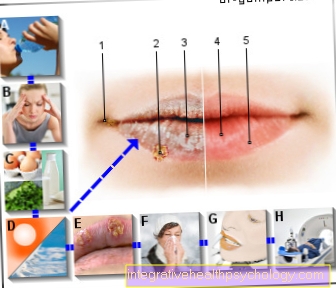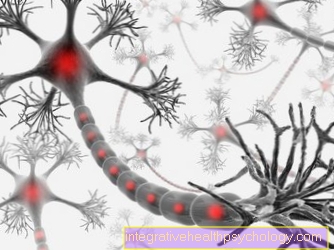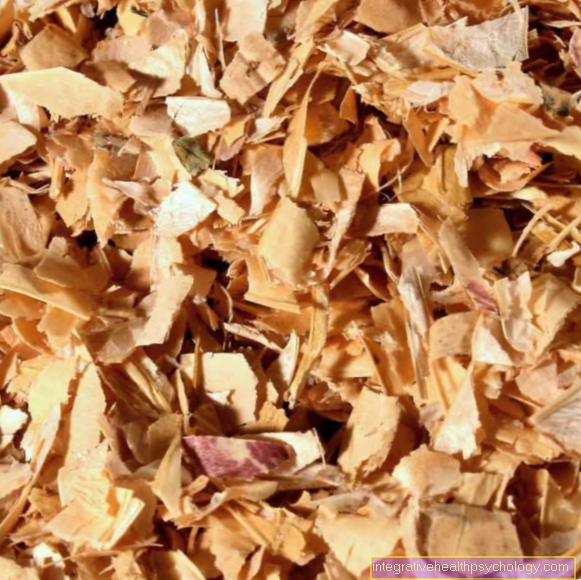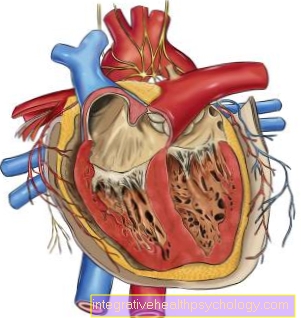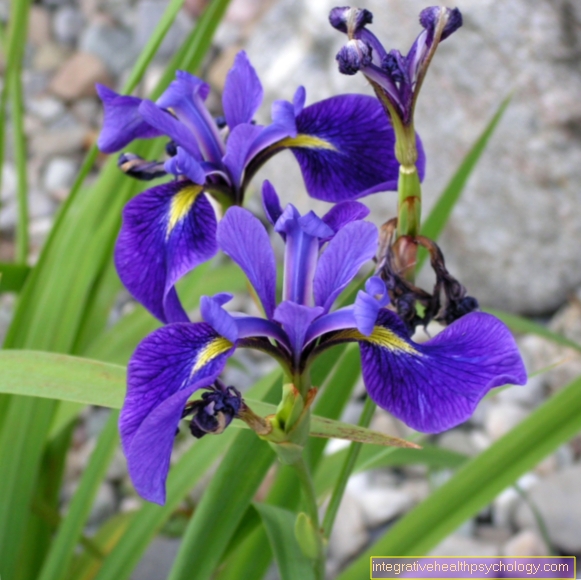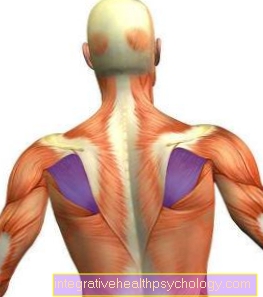Ganglion on the finger
introduction
A ganglion on the finger is colloquial too Over leg called (in technical jargon, however, an excess leg refers to a bony structure). The ganglion is a lump that can develop on a joint capsule or tendon sheath. The ganglion is benign and elastic because it is filled with fluid. It is usually about the size of a pea, but it can also get larger depending on the location. On the fingers, it occurs most often on the extensor side of the terminal joint and on the flexor side of the metacarpophalangeal joint.
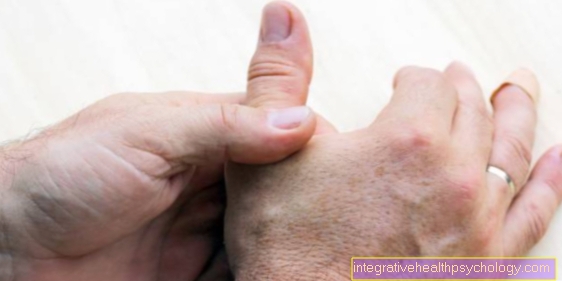
Causes of a ganglion
The exact origin of a ganglion on the finger is still unknown. However, it is certain that there is a connection with chronic irritation of the affected finger. The irritation leads to increased fluid formation.
There is no room for the additional fluid in the joint; instead, the inner membrane of the joint capsule expands outwards through a weak point in the outer shell. Such a chronic irritation can result from overuse of the fingers. Frequent inflammatory processes, such as those that occur in the inflammatory disease rheumatism, can also cause a ganglion on the finger.
It is not uncommon for ganglia to appear spontaneously on the fingers without any discernible mechanism. In addition, trauma to the fingers as a cause of a ganglion is under discussion. What the ganglia have in common, regardless of their location, is that there is a connection between them and the joint space. Through this so-called stalk, fluid can be exchanged between the joint and the ganglion. This is noticeable when moving the fingers, for example. The movement reduces the volume of the joint, the fluid is pressed into the ganglion space, the ganglion swells.
You can recognize a ganglion on the finger by these symptoms
The ganglion on the finger is typically located on the flexor side of the metacarpophalangeal joint or the extensor side of the metacarpal joint. There it is noticeable as a resilient bump, which is usually the size of a pea. The size may change when the affected joint moves. The ganglion is usually filled with a viscous fluid. Other symptoms are often pain in the affected finger and restricted mobility of the joint. In addition, nerve constriction can cause numbness and tingling. Circulatory disorders are also occasionally caused by ganglia, so that the affected finger turns whitish or, in the cold, bluish discoloration. If the ganglion is on the distal phalanx, it can also cause nail changes.
Appointment with a hand specialist?
I would be happy to advise you!
Who am I?
My name is dr. Nicolas Gumpert. I am a specialist in orthopedics and the founder of .
Various television programs and print media report regularly about my work. On HR television you can see me every 6 weeks live on "Hallo Hessen".
But now enough is indicated ;-)
In order to be able to treat successfully in orthopedics, a thorough examination, diagnosis and a medical history are required.
In our very economic world in particular, there is too little time to thoroughly grasp the complex diseases of orthopedics and thus initiate targeted treatment.
I don't want to join the ranks of "quick knife pullers".
The aim of any treatment is treatment without surgery.
Which therapy achieves the best results in the long term can only be determined after looking at all of the information (Examination, X-ray, ultrasound, MRI, etc.) be assessed.
You can find me at:
- Lumedis - orthopedics
Kaiserstrasse 14
60311 Frankfurt am Main
Directly to the online appointment arrangement
Unfortunately, appointments can only be made with private health insurers. I ask for understanding!
Further information about myself can be found at Lumedis - Dr. Nicolas Gumpert
Ganglion pain
In addition to the characteristic bump, pain is the main symptom of a ganglion on the finger. The ganglion itself is usually very sensitive to pressure, and pain can also occur over the entire finger. The movement restrictions in the affected joint are also often pain-related, but the ganglion can also simply act as a mechanical obstacle to prevent movement.
Depending on the position of the ganglion, flexing or stretching the affected finger is more likely to be painful. The ganglion can (especially if it is larger) also press on nerves, vessels, tendons and muscles.
If nerves are constricted by the ganglion, so-called nerve pain can occur. A tingling sensation and numbness can also be triggered by irritation of the nerve. When vessels are compressed, circulatory disorders occur in the affected finger. It turns white or blue particularly quickly when it is cold. Such reduced blood flow can lead to tissue damage, which can also be expressed in pain.
The constriction of muscles and tendons not only results in a painful restriction of movement, it can also lead to reduced muscle strength.
You might also be interested in: Wrist pain
Swelling due to a ganglion
The ganglion itself is more like a small bump on the finger than a large swelling. However, the ganglion can swell as fluid moves from the joint space into the ganglion. When the finger joint is flexed, the space in the joint space itself is reduced. The fluid is pressed into the ganglion through the connecting stalk, the ganglion enlarges.
If the finger is stretched again, the fluid moves back into the joint space and the ganglion shrinks. However, over a longer period of time, a ganglion can also increase in size overall. This increase in size is driven by further stress on the affected finger.
You might also be interested in: Joint swelling on the finger
diagnosis
The diagnosis of the ganglion on the finger is usually a visual diagnosis. During the physical examination, the suspected diagnosis of ganglion can usually be made based on the location and shape of the swelling alone. The ability of the skin to move over the ganglion is used as a clinical test. The ganglion can be punctured to confirm the diagnosis. The fluid is extracted from the ganglion with a syringe, which can then be examined in the laboratory. The ganglion can also be diagnosed using an ultrasound. The focus here is to ensure that the bump is filled with liquid. The stalk connecting the ganglion to the joint can often not be seen. In rare cases, an X-ray is taken of the affected finger to rule out a bony cause of the swelling.
Treatment of a ganglion
Treatment of the ganglion initially consists of immobilizing the affected finger. This usually leads to a regression of the swelling, but this can manifest itself again when the pressure on the finger is resumed. When it recurs, the ganglion can be massaged by hand, thereby pushing the fluid back into the joint. Manual crushing of the ganglion is also used for therapy. If all of these conservative therapy methods are not sufficient, surgical removal of the ganglion must be used.
Puncture of a ganglion
When puncturing the ganglion on the finger, a needle is inserted into the ganglion. The fluid is then withdrawn from the ganglion (aspiration). Such a puncture can serve both diagnostic and therapeutic purposes. Usually both are carried out at the same time, i.e. the entire liquid is aspirated and then examined in the laboratory. A therapeutic puncture can lead to a complete healing of the ganglion, but in about 50% of cases there is a relapse, i.e. a recurrence of the ganglion.
Home remedies
A ganglion can also be treated with home remedies to protect the affected finger. Cooling compresses and ointments help against the pain. Cold applications such as ice packs and cold finger baths are also helpful. Arnica can also be used for pain relief. Since it is assumed that chronic irritation causes the ganglion, anti-inflammatory home remedies can also be used. For this purpose, ginger slices can be placed on the ganglion, for example.
What you might also be interested in on this topic:
- arnica
- ginger
Healing earth
Healing clay can be put on the over leg in the form of compresses and pastes. Healing earth is used for production and mixed with lukewarm water. If necessary, liquids with essential oils can also be used to mix. Depending on the manufacturer, the healing earth contains various valuable minerals that strengthen the body's defenses and thus also support the body's self-healing powers. In addition, the healing clay is placed on the ganglion as a moist pack, this has an additional cooling effect.
homeopathy
Two homeopathic remedies are mainly used for the ganglion on the finger. On the one hand, one uses the Schüssler salt calcium fluoratum. The minerals it contains can strengthen bones and joints in particular, but it also has a positive effect on ganglia. The rue (Ruta graveolens) is particularly used against swelling. It can be given directly on the finger in the form of drops, tablets or globules can also be taken.
When do you need an operation?
Surgery is usually only used for a ganglion on the finger if conservative measures are unsuccessful in the long term. Even if the ganglion is in a particularly unfavorable place, an operation is possible at the request of the person concerned. Especially people who work a lot with their hands and fingers (craftsmen, athletes, musicians) can benefit from an early operation.
Procedure of the operation
The ganglion surgery is usually performed under local anesthesia. After the access to the ganglion has been exposed, the ganglion is carefully cut out of the tissue. It is important to work with millimeter precision so that tendons, nerves, vessels and the capsule are spared. Then follow the stalk up to the joint capsule, tie it off and remove the ganglion completely. After the operation, the affected finger is usually immobilized for some time.
Sick leave after the operation
Since the recurrence rate of the ganglion on the finger is relatively high, a longer sick leave is recommended. Especially if people who work a lot with their fingers are affected, downtime of up to two months can be expected. This is the only way to prevent an early renewed overload. Most people can go back to work after a few weeks (usually four to six weeks).
What to do if the ganglion has burst
A ganglion burst can be accidental and is usually painful. However, there is usually nothing to worry about. The fluid that escapes from the ganglion is usually completely processed by the body within a few days to weeks. In some cases there are even attempts at therapy aimed at rupturing the ganglion. For some people, this can lead to healing of the symptoms. After the ganglion has burst, you should still watch the affected finger carefully, as it can lead to inflammation.
Which doctor treats a ganglion on the finger?
A ganglion on the finger is generally a surgical specialty. As with many other hand complaints, both orthopedic surgeons and hand surgeons can treat the ganglion on the finger. If a long-term observation of the ganglion is necessary, the family doctor can also be involved in the treatment.
Duration / forecast
As a rule, a ganglion persists and only disappears completely by itself in a few cases. The duration of the symptoms therefore depends on how early the ganglion is treated. Since the ganglion often recurs, the symptoms can persist for several months, sometimes even for years. Overall, the duration and prognosis probably depend on the stress on the affected finger.

